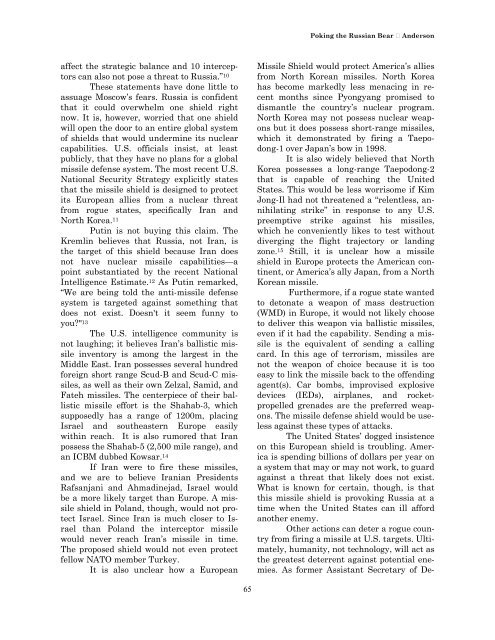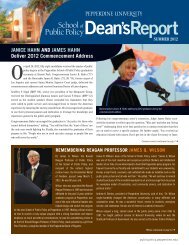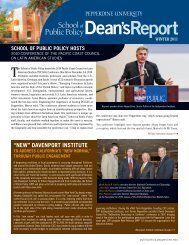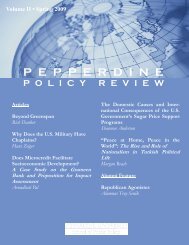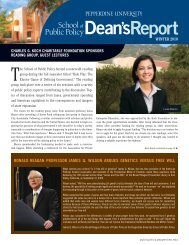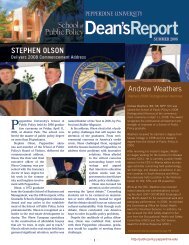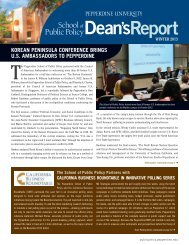Pepperdine University School of Public Policy
Pepperdine University School of Public Policy
Pepperdine University School of Public Policy
You also want an ePaper? Increase the reach of your titles
YUMPU automatically turns print PDFs into web optimized ePapers that Google loves.
Poking the Russian Bear Anderson<br />
affect the strategic balance and 10 interceptors<br />
can also not pose a threat to Russia.” 10<br />
These statements have done little to<br />
assuage Moscow’s fears. Russia is confident<br />
that it could overwhelm one shield right<br />
now. It is, however, worried that one shield<br />
will open the door to an entire global system<br />
<strong>of</strong> shields that would undermine its nuclear<br />
capabilities. U.S. <strong>of</strong>ficials insist, at least<br />
publicly, that they have no plans for a global<br />
missile defense system. The most recent U.S.<br />
National Security Strategy explicitly states<br />
that the missile shield is designed to protect<br />
its European allies from a nuclear threat<br />
from rogue states, specifically Iran and<br />
North Korea. 11<br />
Putin is not buying this claim. The<br />
Kremlin believes that Russia, not Iran, is<br />
the target <strong>of</strong> this shield because Iran does<br />
not have nuclear missile capabilities—a<br />
point substantiated by the recent National<br />
Intelligence Estimate. 12 As Putin remarked,<br />
“We are being told the anti-missile defense<br />
system is targeted against something that<br />
does not exist. Doesn't it seem funny to<br />
you?" 13<br />
The U.S. intelligence community is<br />
not laughing; it believes Iran’s ballistic missile<br />
inventory is among the largest in the<br />
Middle East. Iran possesses several hundred<br />
foreign short range Scud-B and Scud-C missiles,<br />
as well as their own Zelzal, Samid, and<br />
Fateh missiles. The centerpiece <strong>of</strong> their ballistic<br />
missile effort is the Shahab-3, which<br />
supposedly has a range <strong>of</strong> 1200m, placing<br />
Israel and southeastern Europe easily<br />
within reach. It is also rumored that Iran<br />
possess the Shahab-5 (2,500 mile range), and<br />
an ICBM dubbed Kowsar. 14<br />
If Iran were to fire these missiles,<br />
and we are to believe Iranian Presidents<br />
Rafsanjani and Ahmadinejad, Israel would<br />
be a more likely target than Europe. A missile<br />
shield in Poland, though, would not protect<br />
Israel. Since Iran is much closer to Israel<br />
than Poland the interceptor missile<br />
would never reach Iran’s missile in time.<br />
The proposed shield would not even protect<br />
fellow NATO member Turkey.<br />
It is also unclear how a European<br />
Missile Shield would protect America’s allies<br />
from North Korean missiles. North Korea<br />
has become markedly less menacing in recent<br />
months since Pyongyang promised to<br />
dismantle the country’s nuclear program.<br />
North Korea may not possess nuclear weapons<br />
but it does possess short-range missiles,<br />
which it demonstrated by firing a Taepodong-1<br />
over Japan’s bow in 1998.<br />
It is also widely believed that North<br />
Korea possesses a long-range Taepodong-2<br />
that is capable <strong>of</strong> reaching the United<br />
States. This would be less worrisome if Kim<br />
Jong-Il had not threatened a “relentless, annihilating<br />
strike” in response to any U.S.<br />
preemptive strike against his missiles,<br />
which he conveniently likes to test without<br />
diverging the flight trajectory or landing<br />
zone. 15 Still, it is unclear how a missile<br />
shield in Europe protects the American continent,<br />
or America’s ally Japan, from a North<br />
Korean missile.<br />
Furthermore, if a rogue state wanted<br />
to detonate a weapon <strong>of</strong> mass destruction<br />
(WMD) in Europe, it would not likely choose<br />
to deliver this weapon via ballistic missiles,<br />
even if it had the capability. Sending a missile<br />
is the equivalent <strong>of</strong> sending a calling<br />
card. In this age <strong>of</strong> terrorism, missiles are<br />
not the weapon <strong>of</strong> choice because it is too<br />
easy to link the missile back to the <strong>of</strong>fending<br />
agent(s). Car bombs, improvised explosive<br />
devices (IEDs), airplanes, and rocketpropelled<br />
grenades are the preferred weapons.<br />
The missile defense shield would be useless<br />
against these types <strong>of</strong> attacks.<br />
The United States’ dogged insistence<br />
on this European shield is troubling. America<br />
is spending billions <strong>of</strong> dollars per year on<br />
a system that may or may not work, to guard<br />
against a threat that likely does not exist.<br />
What is known for certain, though, is that<br />
this missile shield is provoking Russia at a<br />
time when the United States can ill afford<br />
another enemy.<br />
Other actions can deter a rogue country<br />
from firing a missile at U.S. targets. Ultimately,<br />
humanity, not technology, will act as<br />
the greatest deterrent against potential enemies.<br />
As former Assistant Secretary <strong>of</strong> De-<br />
65


